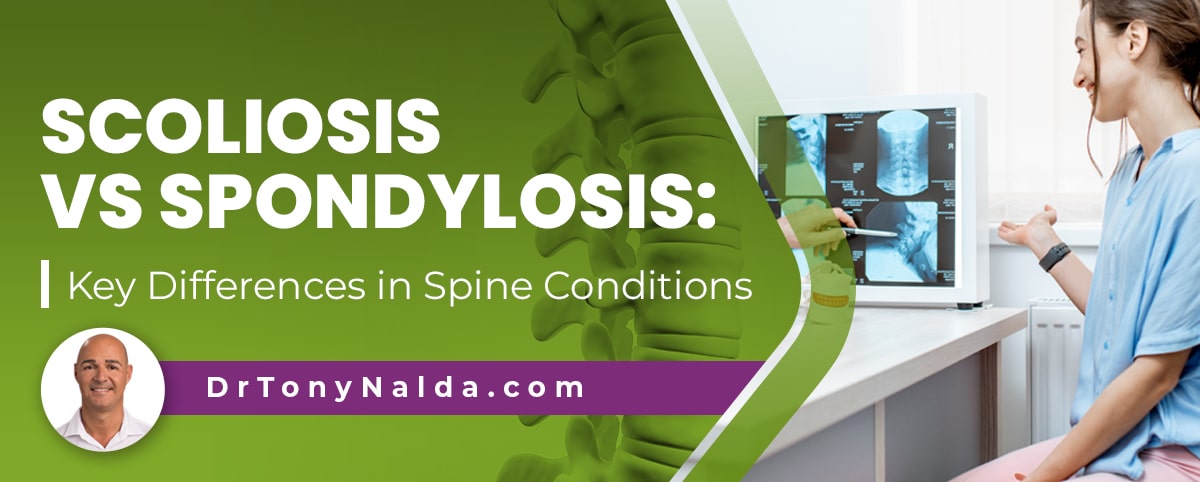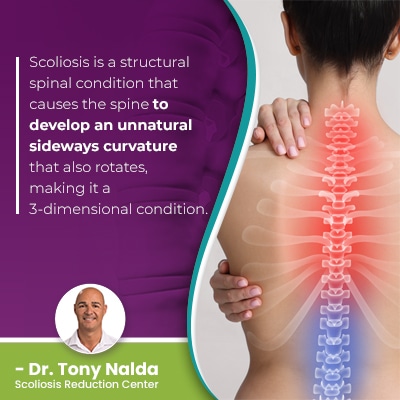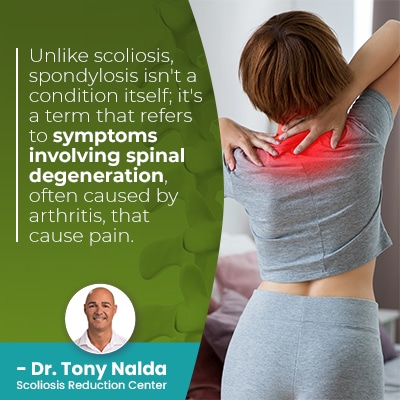Scoliosis vs Spondylosis: Key Differences in Spine Conditions

Scoliosis is a prevalent spinal condition that causes a loss of the spine's healthy curves and alignment. As the leading spinal condition among school-aged children, scoliosis awareness is important; spondylosis, however, isn't a clinical condition and refers to pain caused by spinal degeneration often caused by arthritis.
As such an integral structure of human anatomy, the spine is vulnerable to a number of conditions. While scoliosis is a condition that causes the spine to bend unnaturally to the side and twist, spondylosis is an umbrella term referencing pain caused by spinal degeneration.
A healthy spine is key to overall health; let's start with why.
Table of Contents
Spinal Health
Spinal health can affect quality of life.
A healthy spine will have an 'S' shape when viewed from the sides, and when viewed from the front and/or back, it will appear straight, and this is because the spine is curved at each of its main sections.
The spine has three main sections: the cervical spine (neck), thoracic spine (middle/upper back), and the lumbar spine (lower back).
The spine's healthy curves make it stronger, more flexible, and better able to handle mechanical stress incurred during activity, and if the spine loses one or more of its healthy curves, its vertebrae (bones of the spine) aren't aligned properly as they should be, and this disrupts the biomechanics of the entire spine.
The spine not only allows us to stand upright, engage in a wide range of movement, gives the body structure, and protects important organs, it also works with the brain to form the body's central nervous system.
The central nervous system facilitates brain-body communication so is involved in the function of practically every working part and system within the body, which is why spinal conditions can cause such a wide range of symptoms.
There are a number of conditions that the spine is vulnerable to, including the leading spinal condition among school-aged children: scoliosis.
What is Scoliosis?
 Scoliosis is a structural spinal condition that causes the spine to develop an unnatural sideways curvature that also rotates, making it a 3-dimensional condition.
Scoliosis is a structural spinal condition that causes the spine to develop an unnatural sideways curvature that also rotates, making it a 3-dimensional condition.
Current estimates have close to seven million people currently living with scoliosis in the United States alone, and as a progressive condition, the nature of scoliosis is to get worse over time.
Scoliosis severity ranges from mild scoliosis to moderate scoliosis, severe and very severe scoliosis.
Scoliosis affects all ages but is most often diagnosed in adolescents between the ages of 10 and 18 as adolescent idiopathic scoliosis, and approximately 80 percent of known cases are classified as idiopathic, meaning cause unknown.
The remaining 20 percent of cases are associated with known causes; neuromuscular scoliosis is caused by the presence of a larger neuromuscular condition such as muscular dystrophy, cerebral palsy, and spina bifida, congenital scoliosis is caused by a malformed spine, and degenerative scoliosis involves age-related spinal degeneration.
While we don't fully understand what triggers the initial onset of idiopathic scoliosis, we know what triggers it to progress: growth.
So young patients who have not yet reached skeletal maturity have more potential progression to go through as growth spurts can increase the size of the unnatural spinal curve.
Symptoms of Scoliosis
Scoliosis symptoms are shaped by a number of factors such as patient age, condition type, severity, and curvature location.
No two cases of scoliosis are the same, which is why treatment plans need to be fully customized.
Scoliosis affects children and adults differently, largely because of progression and pain.
As scoliosis progression is triggered by growth, adults tend to progress at slower rates, and as scoliosis doesn't become a compressive condition until skeletal maturity has been reached, the condition isn't commonly painful for children, at least not while still mild.
The constant lengthening motion of a growing spine counteracts the compressive force of the unnatural spinal curve, and it's compression of the spine and its surrounding muscles and nerves that causes the majority of condition-related pain.
Once conditions become compressive, muscle pain, back pain, and pain that radiates into the extremities due to nerve compression are the main symptoms of adult scoliosis.
The main symptoms of childhood scoliosis involve postural changes; the condition introduces a lot of uneven forces to the spine, its surroundings, and the entire body, and these forces can disrupt the body's overall symmetry.
In children, postural changes can include:
- The head uncentered over the torso
- An uneven eyeline
- Uneven shoulders
- Uneven shoulder blades
- The development of a rib cage arch
- Uneven hips
- Arms and legs that hang at different lengths
Changes to balance, coordination, and gait are also common.
What is Spondylosis?
Unlike scoliosis, spondylosis isn't a condition itself; it's a term that refers to symptoms involving spinal degeneration, often caused by arthritis, that cause pain.
A diagnosis of spondylotic changes doesn't indicate the cause of the changes, only that symptoms of spinal degeneration are occurring.
Spondylosis can occur in one spinal section or in more than one as multilevel spondylosis.
Spondylosis Causes
 In most cases, spondylosis is caused by arthritis of the spine which involves inflammation of the joints in the spine, including joints between the pelvis and spine.
In most cases, spondylosis is caused by arthritis of the spine which involves inflammation of the joints in the spine, including joints between the pelvis and spine.
Arthritis can be caused by wear and tear occurring over time, infection, autoimmune diseases, etc.
Spinal osteoarthritis is the most common type of arthritis and causes the loss of protective cartilage that provides cushioning between bones, where they meet, in the joints; this cushioning prevents friction during movement and facilitates normal joint function by lubricating the joints for smooth gliding motion.
Degenerative Disc Disease
Degenerative disc disease is a contributing factor in the development of a number of spinal conditions as the intervertebral discs that sit between adjacent vertebrae perform many key functions: they give the spine structure (adjacent vertebrae attach to the disc in between, provide cushioning between vertebral bodies, combine forces to make the spine more flexible, and act as the spine's shock absorbers.
In most cases of spinal degeneration, it's the discs that are the first spinal structures to feel its effects.
When a disc starts to experience degenerative changes, it doesn't just affect the disc itself, but also its surroundings, including in the spine and its surrounding nerves.
Disc degeneration often involves disc desiccation, and when a disc experiences excessive fluid loss, it can change shape and lose height, and a degenerating disc can easily become a bulging disc and/or a herniated disc.
Bone Spurs
Another cause of spondylosis are bone spurs: bony overgrowths that project from the edges of bones, or where bones meet in the joints.
These overgrowths of bone project into areas they shouldn't, and this can cause compression of the spinal canal, spinal cord, and surrounding inflammation, and arthritic changes.
Bone spurs can develop anywhere in the spine, and in most cases, it's the area of the body located the closest to the affected spinal section that's going to feel the majority of its direct effects.
Conclusion
So while scoliosis and spondylosis both involve the spine, only scoliosis is considered a clinical condition, while spondylosis is a term referencing symptoms of pain and discomfort felt due to arthritic changes within the spine.
While most cases of scoliosis are idiopathic, we know it's growth that triggers progression, and scoliosis types with known causes include neuromuscular scoliosis, congenital scoliosis, and degenerative scoliosis.
Scoliosis ranges in severity from mild to moderate, severe and very severe, and if left untreated, scoliosis is virtually guaranteed to get worse over time.
Scoliosis symptoms can involve postural changes, changes to movement and balance, and pain.
Common causes of spondylosis can include osteoarthritis, disc degenerative changes, and bone spurs.
Common symptoms of spondylosis will depend on the location within the spine but can involve back pain, radiating pain throughout the body due to nerve compression, a number of sensations, and mobility changes.
Spondylosis can range from mild to severe, depending on its cause.
When it comes to treating scoliosis and spondylosis, the underlying cause has to first be determined and treatment plans shaped around it; this is the difference between addressing symptoms, or the cause of the symptoms: the underlying condition itself.
Here at the Scoliosis Reduction Center®, I've treated a wide range of spinal conditions/issues, and the key is conducting a comprehensive physical examination followed by an X-ray to truly see what's happening in and around the spine.
There are many differences between scoliosis and spondylosis, but both can be painful, require a customized treatment plan, and need to be addressed proactively with treatment to improve patients' quality of life.
When it comes to back pain caused by compression and degeneration, the best time to start treatment is always now.
Dr. Tony Nalda
DOCTOR OF CHIROPRACTIC
After receiving an undergraduate degree in psychology and his Doctorate of Chiropractic from Life University, Dr. Nalda settled in Celebration, Florida and proceeded to build one of Central Florida’s most successful chiropractic clinics.
His experience with patients suffering from scoliosis, and the confusion and frustration they faced, led him to seek a specialty in scoliosis care. In 2006 he completed his Intensive Care Certification from CLEAR Institute, a leading scoliosis educational and certification center.
About Dr. Tony Nalda
 Ready to explore scoliosis treatment? Contact Us Now
Ready to explore scoliosis treatment? Contact Us Now





